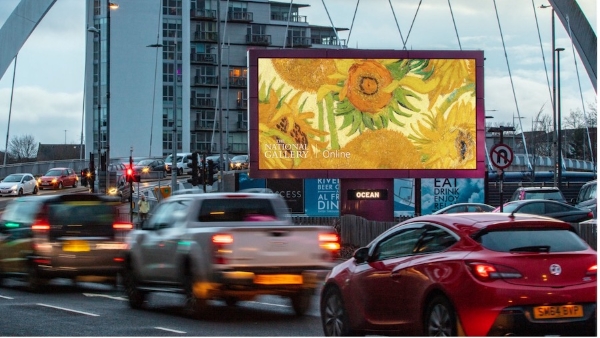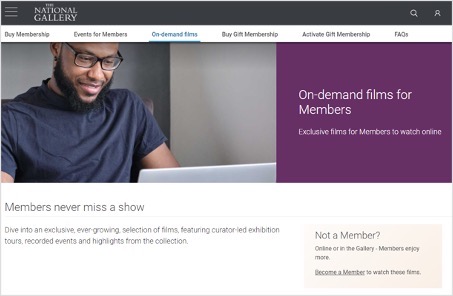Arts and Culture
Business Strategy
COVID-19
Insights & Innovation
2d0a245e-fbe5-4afb-82cd-bedc4350a860
3 min
https://edge.sitecorecloud.io/tessiturane3bae-tessiturane902c-staging-af0b/media/Images/Discover-Images/Thought-Leadership/National-Gallery-768x465.png?h=465&iar=0&w=768
As COVID restrictions ease, Tessitura explores six traits of forward thinking cultural organisations.
The National Gallery’s roadmap out of lockdown

Senior Manager, Product Marketing, Tessitura
The National Gallery’s roadmap out of lockdown
5/19/2021
3 min
As the pandemic hit and the country closed down, the National Gallery went through the same shock as everyone else.
However, as it emerged from that initial crisis, rather than focusing on what it didn’t have — an open building — it recognised the assets that it did have: a digitised collection, a respected brand, loyal members, and talented staff.
As cultural institutions in the UK prepare to reopen again, we at Tessitura reflect on the successful innovations The National Gallery applied when coming out of the first lockdown 1.0. This leading museum helped outline the cultural sector’s roadmap out of lockdown through six key traits.
We have consistently witnessed one or more of these six traits in organisations that are thriving despite the challenges of COVID. The National Gallery continues to be forward-looking, creative and resourceful as it reopens, serving as an example to us all in the arts and cultural industry. Here are the six traits and how it has achieved them.
1. Engage all audiences
National Gallery, along with many peers, quickly realised that engaging audiences in lockdown meant inviting people to view its online collection. Broadening its footprint beyond normal channels, the National Gallery sought to engage the whole country by placing digital billboards of some of its great works in cities up and down the UK.

This strong brand presence brought joy to essential travel. Plus, it ensured the National Gallery’s name and art was remembered and accessible from anywhere. It was an incredibly successful way to engage all audiences and point people to the digital collection.
The museum can also measure success by the increased number of known individuals in its Tessitura system over the course of the pandemic.
2. Continually strengthen relationships
Beyond engaging audiences, the National Gallery quickly realised that strengthening its relationships with members and loyal visitors would be key to recovery before it could reopen.
The Commercial team, led by James Beardsworth-Shaw, Head of Commercial Services, became the crux of many efforts. They worked closely with other departments on new ways to ensure members remained engaged.
In-person, being a member of the National Gallery gives you priority and free access to exhibitions with your membership card. As it moved to an online gallery, the commercial team, along with curators and digital experts, ensured that the benefits of being a member weren’t lost in the virtual world.

With Tessitura’s virtual experiences, members could easily log in and be recognised. So, they could pick up a virtual exhibit and view it directly from their account, ahead of the general public.
This collaboration continued, as the Gallery team created more and more online events and experiences. The new department alignment allowed it to provide priority and exclusive access for members. This meant it was strengthening relationships by providing virtual experiences and content not available anywhere else.
3. Diversify revenue streams
Whilst strengthening relationships, the team was also able to build different revenue streams.
For some time, the National Gallery has held a popular lecture series in its 300-seat theatre. Unable to continue the series in person, it chose to continue it online, for just £10 per person.
The pivot to digital increased capacity and the Gallery was regularly seeing audiences of far more than 300. Even more significantly, it was also reaching international markets. Because of this greater reach, it is expecting to keep this revenue stream. Even after the in-person lectures resume.
• • •
This is an excerpt from an article on Blooloop.
Top photo by Diego Delso from Wikimedia Commons.
Topics
Arts & Culture
/Business Strategy
/COVID-19

Planning for High-Volume On-Sales (The Donut Problem)
Arts & Culture / Business Strategy / Customer Service / Digital / IT & Systems / Technology / Ticketing & Admissions
Kristin Darrow offers her advice for managing a large ticket on-sale where demand outstrips supply, while maintaining a good customer experience throughout

Des Moines Performing Arts | Success Story
Digital / Business Strategy / IT & Systems / Presenting & Performance / Theatre / Ticketing & Admissions
Denise Smithson Green describes how Des Moines Performing Arts achieved a record on-sale for Hamilton